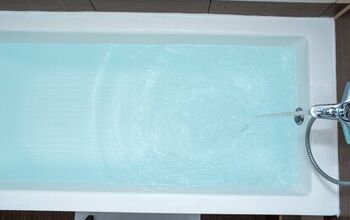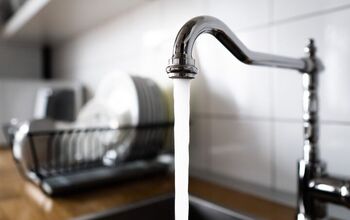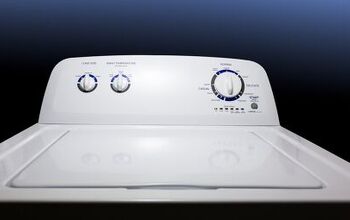Why Is There Water In My Dryer?

Your dryer has one purpose, to dry clothing, towels, and other items using heated air. Therefore, it can be alarming to open your dryer and find water inside the drum or leaking underneath the appliance. Since your dryer’s main aim is to get rid of moisture, why is there water in your dryer?
The main reason a dryer leaks water is blocked ventilation or poor insulation. A dryer dries clothing and other materials using heated air that circulates around the drum, drying the contents. You have a dryer vent that sends the warm air outside the home. But blocked ventilation or inadequate insulation leads to condensation and water inside the dryer.
The first way to stop water from collecting in your dryer is to identify the cause. Ventilation issues are the most common reasons for water in your dryer, but it’s worth familiarizing yourself with the specifics. The good news is that you would unlikely need to hurry out and purchase a new appliance.
Why Is Water Leaking Underneath My Dryer?
There are several reasons for water in your dryer, and most have easy fixes. If your dryer is leaking water or collecting water in the drum, here are the likeliest reasons.
1. Poor Insulation
If your dryer leaks mostly during cold weather, the issue could be with the insulation. When the warm air that’s venting outside meets with cold outdoor temperatures, insulation helps prevent condensation.
However, if there’s no insulation or inadequate insulation to help with this temperature difference, condensation will form. As more condensation forms, it can start to leak onto your floor or lead to water in your dryer.
2. Blocked Ventilation
Remember your mom always reminding you to clean out the lint trap after you dried your clothes? You’re also supposed to clean out your dryer’s exhaust regularly. It’s for a good reason.
As your dryer works, it circulates hot air through the drum to dry the contents of the dryer. This warm air isn’t supposed to hang around inside the dryer; otherwise, it would overheat.
This is why there’s a venting system that leads outside. The warm air travels through the vent collar, to the external vent, and outside your house.
But, this air contains other things, like moisture and lint, that turn into a goopy substance that can build up over time. Eventually, if left untouched, these elements cause a blockage that prevents the warm air from exiting outside.
Instead, it stays behind, condenses, and ends up as condensation in water inside your dryer and dryer vent. Other things that could cause a potential blockage or if rodents or debris get into the vent pipe from outside and become stuck there.
3. Faulty Water Collection System
If you have a condenser dryer, the collection system might be damaged or not working properly. Condenser dryers feature a heat exchanger that takes moisture from the warm air and stores it in a small tank.
Other models might pump the water away, but either way, the system pumps the heat back into the room. If the water collection system isn’t working correctly, you could end up seeing water inside the dryer or leaking from the dryer.
4. Improper Ventilation Duct Configuration
In order for your dryer to function optimally, the ventilation duct should be as straight as you can get it. Multiple bends, turns, or a duct that’s too long can lead to improper ventilation.
The air will have farther to go, or the longer pipe is more likely to end up with kinks that prevent adequate airflow. If your dryer vents inside, for example, into a garage, this could also lead to more condensation issues.
5. Damaged Flapper On Vent Pipe
Check the end of the vent pipe outside and see if it has a flapper. If so, it should always remain closed unless you are using your dryer. Otherwise, it should remain securely shut.
If it doesn’t stay closed when not in use, it can allow outside elements, like rain or snow, to enter your dryer through the vent. You’ll end up with water inside your dryer vent and potentially inside your dryer.
6. Damaged Dryer Vent Pipe
If your vent pipe has cracks or any other damage, it won’t work correctly. If it can’t function appropriately, it leads to condensation and water leaking from the dryer. Even a tiny hole can lead to moisture problems, so don’t underestimate even the smallest of issues.
Why Is Dryer Leaking Water From The Door?
If your dryer is leaking water from the door while it’s running, it could be that the door isn’t shut properly. The difference between the temperatures inside the drum and outside the dryer can lead to condensation and leaks.
The door or the seal could possibly be damaged, so it can’t fully close or adequately seal. Check the door to make sure it is working correctly. Also, check the gasket seal to make sure it isn’t damaged or dirty.
You can clean the gasket with a non-abrasive cleaner and damp sponge. Make sure to get rid of all cleaning product residue before running the dryer.
How To Fix Condensation And Water In Dryer Or Dryer Vent
Once you’ve identified the reason for the condensation or water in your dryer, you can take the steps to fix it.
1. Fixing Poor Insulation Causing Water In Dryer
If the insulation around the dryer vent pipe is non-existent or only around certain parts of the line, it leads to condensation. Make sure that the vent pipe is insulated along the entire length of the pipe to avoid fluctuations in temperature.
2. Fixing Blocked Ventilation
Go outside to where your dryer vent is and hold your hand under the vent. You should feel some airflow, but if you don’t, there’s likely a blockage.
You can help prevent the build-up of lint in your exhaust system by emptying and cleaning the lint trap every time you run the dryer. Additionally, you should clean out your dryer’s exhaust system once per year using a brush to get rid of any accumulated goo and debris.
Turn off the power to the dryer, disconnect the vent pipe, and use a vacuum attachment to clean out the pipe. You can also find dryer vent cleaning kits at hardware stores or online. When you reattach the vent pipe, make sure it’s free of any kinks or damage.
3. Dealing With A Faulty Water Collection System
You’ll have to do some troubleshooting to determine why the water collection system isn’t working properly. Make sure to disconnect the dryer from all power sources first.
You can remove the condenser pump and clean out all of the hoses. You can do this with a simple bottle brush.
Inspect the tank for any cracks and ensure the pump and level switch are in good working order. Also, make sure your dryer is level and check all gaskets and seals. In some cases, you may need to order replacement parts or call in a professional service.
4. Improving Ventilation Ducting To Prevent Water In Dryer
Ensure the ducting for your dryer vent is as horizontal and straight as possible. Your dryer should be positioned as close to the outside vent as possible to prevent needing a long ventilation duct.
If the ducting is bunched up and has too many bends, it’s likely too long. You need to cut it down or purchase a shorter one.
Also, consider what material your ducting is made of. Plastic and ribbed ducting tend to hold onto water more than non-ribbed metal ducting. If possible, switch to these types of ducting for your dryer. You should never use PVC for your dryer vent pipe as it can result in melting and fire hazards.
If your dryer vents indoors, it’s worth trying to relocate it outside. This can help avoid condensation issues from temperature variations.
It’s also safer to vent your dryer to the outside, especially if you have a gas dryer. You can consult with a professional to see if this is possible for your specific situation.
5. Fixing Damaged Vent Parts
If you’re dealing with a damaged flapper, you can replace it. But check the vent for blockages first. If the pipe is blocked, the flapper won’t work properly.
If there’s nothing blocking the line, it’s more likely a damaged flapper. The flapper can become rigid over time and not able to open and close as easily.
If the vent pipe has a hole or cracks, you might need to call a pro or have it replaced. If it is just a tiny hole, you could possibly seal it using heavy-duty heating and cooling tape.
Summary
You count on your dryer to get your towels, sheets, and clothing dried safely and efficiently. But if there’s water collecting in the dryer’s drum or leaking from the appliance, your dryer can’t do its job. The most likely reasons for water in your dryer are poor insulation or ventilation issues, like improper configuration or blockages.
There could be a blockage in the vent from built-up lint and other debris. This blockage prevents warm air from exiting the duct, leading to condensation, water inside the dryer, and leaks.
There could also be a damaged vent pipe or flapper leading to water issues. If your dryer uses a flapper and the flapper doesn’t stay closed, you’ll end up with water in your vent from rain, snow, and other outside elements.
Most issues you can easily address yourself, but for others, like a damaged vent pipe, you’ll likely need a professional. Once you determine the problem, you can troubleshoot through the potential fixes so you can get your dryer back in shape.

Stacy Randall is a wife, mother, and freelance writer from NOLA that has always had a love for DIY projects, home organization, and making spaces beautiful. Together with her husband, she has been spending the last several years lovingly renovating her grandparent's former home, making it their own and learning a lot about life along the way.
More by Stacy Randall



























